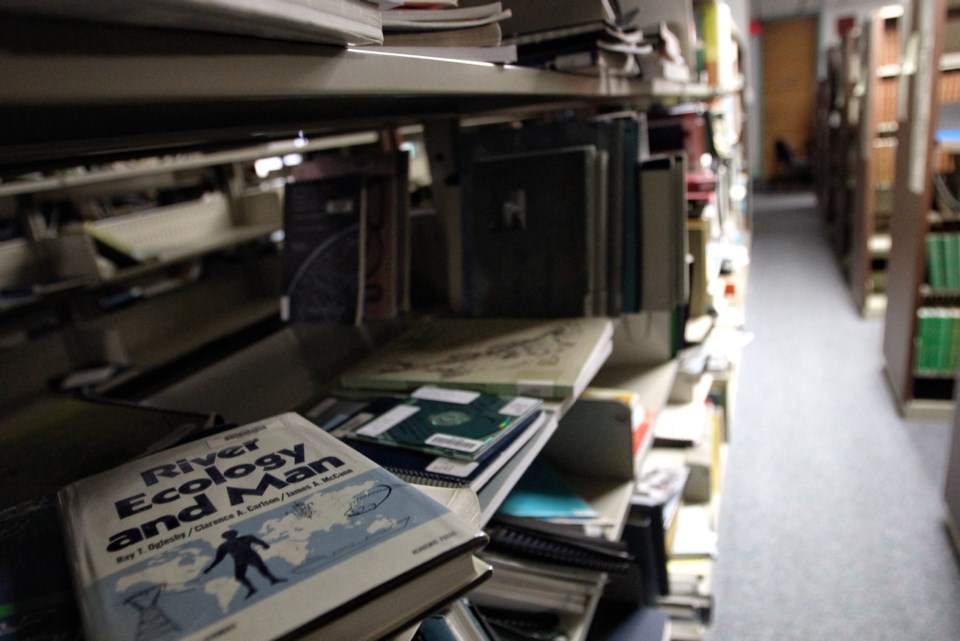 Right, here I am back from the 15-day suspension I got for going all Tortorella and trying to fight my way into the CBC newsroom. Time to follow up on a couple of recent columns.
Right, here I am back from the 15-day suspension I got for going all Tortorella and trying to fight my way into the CBC newsroom. Time to follow up on a couple of recent columns.
• Much of the uproar over the closing of federal science libraries has focused on those run by the Department of Fisheries and Oceans. Critics are aghast that documents were given away or simply thrown out as collections were consolidated across Canada. A photo taken outside the DFO library on Quebec’s Gaspé peninsula, showing a garbage bin piled with scientific literature, has come to symbolize the story.
Less fuss has been made over the loss of Environment Canada, Health Canada and other libraries — including the Canadian Forest Service one at Saanich’s Pacific Forestry Centre. It closed early last year.
As might be expected, the Burnside Road collection didn’t see much use by the public, but its loss was still felt keenly by a those who work in the field.
“I require access to research articles for much of my work,” writes Victoria’s Kevin Brown, a consulting forest ecologist and researcher. “This can be inconvenient and expensive ($30-plus per article) when one works independently and is not associated with either a government or academic institution.
“The PFC library not only provided electronic access to journal articles, but had a very good collection of older journal volumes and government research reports (from the U.S. and other countries, in addition to Canada) in the stacks — useful for browsing and often not accessible online.
“Given the nature of forests and forest research, much of that research was useful, even if ‘old’; some also was probably not available online. I understood that all CFS libraries at regional labs were closed and the lab in Sault Ste. Marie designated as the repository from which staff in other federal forestry labs could request copies if not online. The PFC paper volumes were apparently shredded because ‘no one wanted them.’ Until it closed, the lab at PFC was the best resource for published forestry research on Vancouver Island.”
• If Saturna Island’s Pat Carney finds a high enough vantage point, she might be able to peer over to Mayne Island and the latest lighthouse to earn heritage protection under a bill she drove through Parliament.
Just before retiring from the Senate in 2008 (and after a decade of trying), Carney pushed through the Heritage Lighthouse Protection Act, which prevents Ottawa from destroying historic lighthouses without first consulting the public.
Designation also means Mayne’s Active Pass lighthouse, familiar to all who ride the Swartz Bay-Tsawwassen ferry, must be maintained to conservation standards.
Also given protection last week was the light at Estevan Point on Vancouver Island’s isolated west coast. The Hesquiat Peninsula light is famous for being attacked by a Japanese submarine during the Second World War.
Last year, the Fisgard lighthouse off Colwood and Saturna’s East Point light station were the first to win heritage status.
• Leslie Rejminiak had planned to ride this summer’s Ride to Conquer Cancer, joining fellow Victorian Hazel Prince, a cancer survivor who had cycled the Vancouver-to-Seattle event last year.
That was before Rejminiak’s own breast cancer diagnosis in November, followed by surgery in December. She begins 15 months of chemotherapy this month.
“But Leslie is a very tough lady,” writes Prince. “She is so strong that she is going to pre-emptively and publicly have her head shaved to help me in my fundraising efforts and to get more people involved in the fight against cancer.”
It will happen at 5 p.m. Saturday at a gathering of their TriStars triathlon training friends. Those who are willing to say goodbye to their hair/donation dollars are invited to email hazelprince@shaw.ca.
• Local historian Kathleen Trayner responded to my Alice-down-the-rabbit-hole version of Victoria’s history with a non-fiction nugget.
“In the 1930s, the Saanich Pioneer Society actually kept adjusting the length of time one had to have been in the area to be named ‘a pioneer,’ ” she writes. The idea was to include their pals. “They started with 60 years and eventually had to whittle it down to 25.”
And here I thought anyone with less than 50 years in Victoria was a newcomer.



